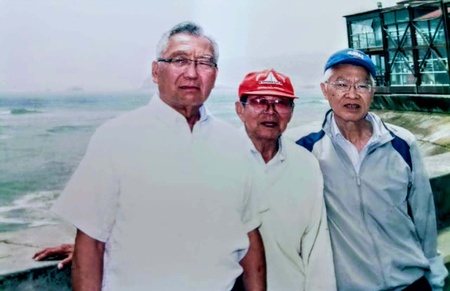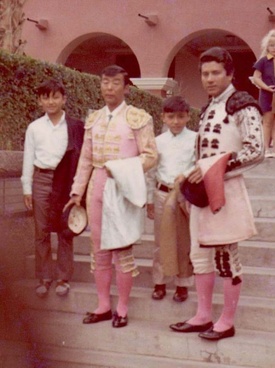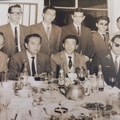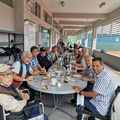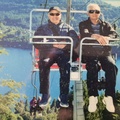Year 1956. It was the year I dared to send a poem of my inspiration to the Peru Asahi Shimbun newspaper. What would be my surprise that my composition was published in the pages of the newspaper. That same year I sent another poem to the newspaper Perú Shimpo, which also agreed to publish it. Some time later, NIKKO magazine published my compositions and in Lima, in the sixties, Superación magazine gave me space in its pages. In the publications he wrote under a different pseudonym. In those years, Perú Shimpo had, on Sundays, a special page for contributors of both poetry and prose and stories.
By 1958, the Christmas holidays marked a singular attraction in my life in the small and picturesque city of Jauja, which I traveled through daily and at full throttle on my Hercules bicycle. I distributed the two community newspapers and that Easter I had the surprise of my life. The editor-in-chief of the newspaper Perú Asahi Shimbun was kind enough to send me a nice and memorable Christmas card by mail. It was signed by Mr. Ricardo Mitsuya Higa. I still have that beautiful memory as part of a modest and sincere tribute. For the more than sixty years of my friendship with Mitsuya.
In the many afternoons that we shared tennis at the AELU, around 1995, Mitsuya gave me classes on his 'courts'. From him I learned to handle the racket with my wrist, which he learned in his afternoons in Spain, when he practiced bullfighting and took time to be an extra in the big movies that were filmed at that time. A globetrotter like himself, Ricardo Mitsuya Higa had a column in the newspaper Perú Shimpo , his writings were expected every fourteen days. On Thursdays he alternated with Don Chihito Saito, both were the main editors in the Spanish section of the newspaper.
'Three Arrows' was Mitsuya's pseudonym and his style was a precise, simple narrative full of emotions that enveloped his readers. Don Chihito Saito had the pseudonym 'Don Jueves'. On the times I visited Perú Shimpo , Mitsuya would make me go to the newsroom and from there to have a coffee at a nearby place. He always showed me interest in my writing and seriously recommended certain aspects of my writing. He knew that I had not studied journalism or anything like that, therefore, he had a special affection for me. He recommended certain advice to me and told me very seriously: “Your inspiration is what matters.”
I gave up my love of writing for a long time, but I always had in mind what I learned with Mitsuya. When the Perú Shimpo publishing house moved to Callao, the years had already distanced us from all the advances that today shine in each editorial office. Since Mitsuya was seven years ahead of me (I would have turned 87 this year) it was to be expected that entering old age would distance us on the path of survival. Time did not pass in vain. And in a meeting in his beloved Callao, we looked, as always, for the gathering and the coffee that would accompany us.
Never a complaint, perhaps the loneliness of the years was able to understand it. One afternoon, while I was finishing distributing my merchandise, I saw him near Channel 4.
“Hello, Mitsuya! Why do you come to these places?” “I live near here and I'm going home.”
"I carry you". I stopped the truck and he got in.
Our next stop was a coffee shop. It was two hours of conversation, of memories, of getting closer to what the days were like in Jirón Puno, when the newspaper Perú Shimpo had the splendor of its large premises, and where in the late fifties and early sixties the newspaper sponsored and organized ping pong championships with countless tables in the large space on its second floor. The clubs at that time, San José, Zamudio and Tres Estrellas, in Huacho, among many others, made us vibrate with the sport of table tennis. It was a wonderful seedbed within the Japanese community that has never been developed again in the years to come.
The other thing was the newspaper's audience. regular and welcoming. I told Mitsuya that we once used the place for an afternoon of musical entertainment with artists from the neighborhood. Samuel Matsuda and I, among others, made the task of raising funds for the San Juan de Dios Clinic Home possible. We did well thanks to the selfless collaboration of the Nisei artists of that time.
And it was with Samuel Matsuda that I first visited Mitsuya at the Las Hermanitas de los Ancianos Desamparados asylum in Callao. We arrived around two in the afternoon and invited Mitsuya to take a walk around the port and La Punta. While he was getting ready we took a tour of the interior of the asylum. A beautiful and simple chapel caught our attention. That divided the part of the ladies and gentlemen. Its living rooms are spacious and airy, as are its bedrooms. The retirement house was of a solid and noble structure, full of light. After a while Mitsuya came out with a classic hat and the three of us got into my car. The port and the sea of Callao looked like a compromise for tourists. A warm sun full of reflections militated over the waters of the coast of La Punta. We had lunch at a cebichería and finished enjoying a coffee with sweets in a huge cafeteria. When five in the afternoon arrived, and already back, Mitsuya just tilted his cap, widened a smile, looked at us as if we were three boys in the years of our youth and closed the door of the asylum behind him.
On my second visit, Carlitos Yamanija accompanied me. “Luchito,” he told me, “when do we visit the Bullfighter?” “Anytime, Carlitos,” I replied. “Then let's go tomorrow and I'll pick you up at one in the afternoon.” As I already knew the way and the exact place we arrived in a short time. Entering the asylum was a little difficult for us. The doorman and a nun didn't want us to take Mitsuya out. That day he was feeling a little bad and they feared a relapse. After convincing them that it was only for two hours, they agreed.
We found Mitsuya on one of the benches resting with his classic beanie. Next to him are the daily newspapers. He had permission to go out and every morning he went to the newspaper and magazine stand. When he saw us, a pale smile lit up his face. There I noticed that the years were already taking their toll on him. The three of us left in my car and returned to the port and the coast of La Punta. When passing by the Club Regatas Unión Carlitos Yamanija remembered that he had visited a good restaurant in the area. Upon entering a small dock, and then into the dining room of “La Rana Verde”, we were surprised by a wonderful spectacle of the Mar de Grau. Ships, barges, barges, boats and all marine vehicles rested in its calm waters that day of splendid sunshine. The memory was assured. The photos were kind enough to capture pleasant moments and the food was magnificently good. From there we went on to visit La Punta throughout its entire route and lastly the inevitable coffee.
The discussion focused on the years that Mitsuya played tennis at AELU. Carlitos Yamanija followed him in history for being one of the oldest tennis players and knowing most of the iseis who played at that time. A very beautiful and pleasant time, he told us. Late, upon returning, the farewell was a handshake and I reminded him that his 'Three Arrows' column was the best I have read in the pages of Perú Shimpo . He squeezed my hand and in a few words told me that this pseudonym had an important meaning in his life.
Three months ago, in the first days of January, when we were at the AELU Tennis facilities, Julio 'Pancho' Gushiken suggested I visit Mitsuya. I have fond memories of him, Pancho told me, and one of them was visiting the Acho Bullring. It was in a bullfight in homage to the Lord of Miracles. Who better than Mitsuya to teach me the secrets, the customs, the prizes, the livestock, the gangs, the capes, the banderillas, the picador on his noble horse, the time of touch as the bull passes to death. Quite a ceremony with a square full of fans, and with open shouts they let us hear the famous "oles!" I was impressed by the fervor and culture of a tradition that lives and vibrates in many Bullrings scattered throughout the country and the world.
I accepted his proposal and told him that I would call Carlos Tadao Saito. He also informed me that he wanted to visit Mitsuya. “Delighted!” Pancho replied. The more there are, the happier Mitsuya will feel. Carlitos Saito in a recent meeting expanded on Mitsuya and recalled his time at the Reserve Bank. The memories of his friendship with Mitsuya were pleasant and emotional.
And in mid-January of this year, in Pancho Gushiken's car, we surprised Mitsuya. We follow the same route as the previous visits. The sea was the obligatory custom to keep in mind. What chalaco doesn't love the sea? And what Nikkei doesn't have that attachment to the sea breeze? The four of us sat down again to the gathering at “La Rana Verde”. The calm sea, the calming breeze, the seabirds disturbed the places near the restaurant. The stillness of the place gave us a chat of memories with other generations. Pancho, the youngest, and Mitsuya, the oldest. When I saw him, after the visits with Samuel Matsuda and Carlos Yamanija, I was concerned about his state of health, from being able to speak little to almost nothing; and from savoring dishes with sea flavors to having little appetite. Taciturn almost the entire way, in the little he spoke, he was a figure that was further removed from reality. There was no coffee simply because I didn't want it anymore. Upon returning to his nursing home, he thanked us, bowed, and disappeared after closing the door. I commented to Pancho and Carlos: “I've seen Mitsuya strange.” Or perhaps it is strange that the years are winning the race over the almanacs.
Today, after the news on WhatsApp from my friend Manuel Nakanishi about the death of Ricardo Mitsuya Higa, and in the middle of quarantine due to the coronavirus, I went to my balcony to contemplate the AELU. I felt the stillness of sixty-two years of friendship in an opaque, faded Christmas card. He had his miracle at the end of the road and on the calm waters of Callao.
I thanked Mitsuya for my first verses, for correcting me on an office paper, and for simply advising me. “Your inspiration is what matters.”
© 2020 Luis Iguchi Iguchi



